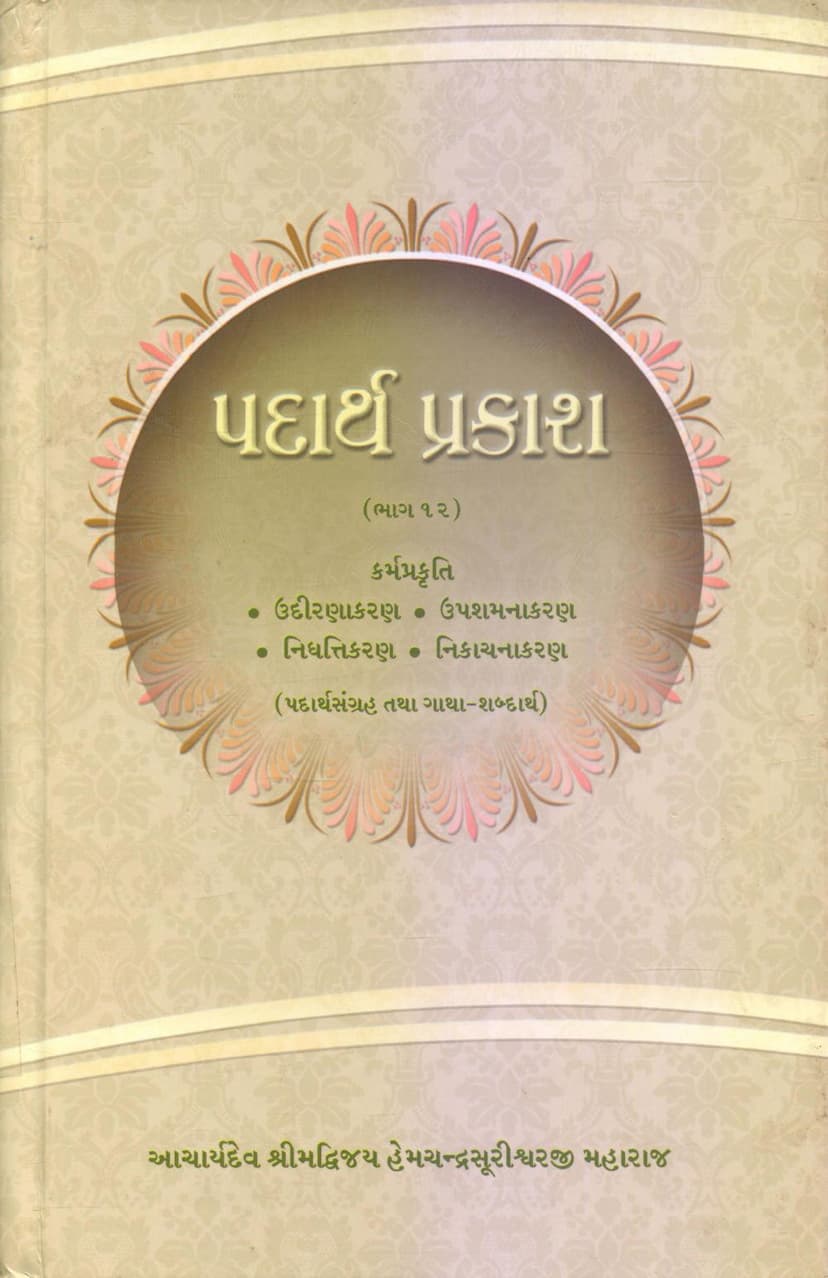Padarth Prakash 12 Karm Prakruti Udirnakaran Upashamanakaran Nidhattikaran Nikachnakaran
Added to library: September 2, 2025

Summary
Here's a comprehensive summary of the Jain text "Padarth Prakash Part 12: Karm Prakruti - Udīraṇākaraṇ, Upśamanākaraṇ, Nidh'tikaraṇ, Nikāchanākaraṇ" authored by Vijayhemchandrasuri, based on the provided pages:
Overview:
This volume, "Padarth Prakash Part 12," by Acharya Shrimad Vijay Hemchandrasurishvarji Maharaj, is a detailed compilation and explanation of specific aspects of Karm Prakruti (the nature of karma) within Jain philosophy. It specifically focuses on four key processes:
- Udīraṇākaraṇ (उदीरणाकरण): The process of causing karma to mature and manifest prematurely.
- Upśamanākaraṇ (उपशमनाकरण): The process of suppressing karma's manifestation.
- Nidh'tikaraṇ (निधत्तितकरण): A state of karma where it cannot be modified by certain processes.
- Nikāchanākaraṇ (निकाचनाकरण): A state of karma where it cannot be modified by any process.
The text aims to provide a clear and accessible understanding of these complex karmic concepts, including the collection of principles (Padarth Sangrah) and the meaning of the original verses (Gatha-Shabdarth). This volume is part of a larger series aimed at illuminating the meanings of various Jain scriptures.
Key Concepts and Contents:
The book is structured to systematically explain these four karmic processes through detailed analysis of their causes, effects, and the spiritual stages (Gunasthans) involved.
1. Udīraṇākaraṇ (उदीरणाकरण):
- Definition: Udīraṇākaraṇ refers to the special vital energy (Virya Vishesh) that draws karma particles from a higher positional state (above the Udayāvalikā - the period of manifestation) and brings them into the Udayāvalikā, causing premature fruition.
- Types: Udīraṇā is categorized into four types:
- Prak'rti Udīraṇā (प्रकृति उदीरणा): The premature manifestation of the type of karma.
- Sthiti Udīraṇā (स्थिति उदीरणा): The premature manifestation of the duration of karma.
- Ras Udīraṇā (रस उदीरणा): The premature manifestation of the intensity or potency (Ras) of karma.
- Pradesh Udīraṇā (प्रदेश उदीरणा): The premature manifestation of the quantity or extent of karma particles.
- Analysis: The text delves into the distinctions, origins (Sādi/Anādi), permanence (Dhruva/Adhruva), and the specific stages (Gunasthans) and types of souls (Jivas) responsible for each type of Udīraṇā for both primary (Mul Prakruti) and secondary (Uttar Prakruti) karmas. It provides extensive tables and classifications detailing the specific karmic qualities (Bhanga) and their associated souls and stages. For instance, it meticulously details the Prakruti Udīraṇā of various specific karmas like Jñānāvaraṇ, Darśanāvaraṇ, Mohaniīya, Ayushya, Nāma Karma, Gotra, and Antarāya, outlining their Sādi/Anādi and Dhruva/Adhruva characteristics. The text also includes detailed tables enumerating the specific Udīraṇā locations and the souls responsible for them, particularly for Nāma Karma across various types of beings (Ekendriya, Viklendriya, Panchendriya Tiryanch, Manushya, Deva, Nāraki, Kevali).
2. Upśamanākaraṇ (उपशमनाकरण):
- Definition: Upśamanākaraṇ is the process of making karma unsuitable for fruition, Udīraṇā, Nidh'tikaraṇ, and Nikāchanākaraṇ through a special vital energy (Virya Vishesh).
- Types:
- Sarva Upśamanā (सर्वोपशमना): Complete suppression of karma, also known as Guṇopśamanā or Praśastopśamanā. This applies only to Mohaniīya (delusory) karma and is considered a pure form of suppression.
- Deśopśamanā (देशोपशमना): Partial suppression of karma, also known as Aguṇopśamanā or Aprāśastopśamanā. This can be further divided into Karankr̥t (achieved through specific spiritual efforts) and Akaraṇakr̥t (achieved through natural spiritual development). The text focuses on Karankr̥t Upśamanā.
- Processes: Upśamanā involves processes like Yāthāpravr̥ttakaraṇ, Apūrvakaraṇ, and Anivrttikaraṇ.
- Rights (Adhikars): The book outlines nine specific rights or chapters dedicated to explaining Upśamanākaraṇ:
- P'ratham Upśam Samyak'tva Prāpti Adhikār (Attainment of initial Samyak'tva through suppression).
- Deśvirati Lābh Pra'rūpaṇā Adhikār (Explanation of gaining partial restraint).
- Sarva Virati Lābh Pra'rūpaṇā Adhikār (Explanation of gaining complete restraint).
- Anantānubandhī 4 Visanjōjanā Adhikār (Separation of the four Anantānubandhī passions).
- Anantānubandhī 4 Upśamanā Adhikār (Suppression of the four Anantānubandhī passions).
- Darśan 3 Kṣapaṇā Adhikār (Destruction of the three Darśan Mohaniīya karmas).
- Darśan 3 Upśamanā Adhikār (Suppression of the three Darśan Mohaniīya karmas).
- Chāritra Mohaniīya Upśamanā Adhikār (Suppression of Chāritra Mohaniīya karma).
- Karaṇakr̥t Deśopśamanā Adhikār (Partial suppression achieved through effort).
- Details: The text explains the stages of spiritual development (Gunasthans) where these processes occur, the nature of the souls undertaking them, and the specific karmic qualities affected. It elaborates on the intricate steps involved in achieving Samyak'tva and different levels of restraint through Upśamanā.
3. Nidh'tikaraṇ and Nikāchanākaraṇ (निधत्तिकरण-निकाचनाकरण):
- Nidh'tikaraṇ: This is a state where karma particles are made incapable of undergoing processes like Ud'vartaṇākaraṇ (enhancement) and Apavartaṇākaraṇ (diminution), but remain susceptible to other karmic modifications.
- Nikāchanākaraṇ: This is a more severe state where karma particles are rendered incapable of undergoing any karmic modifications, including Ud'vartaṇā, Apavartaṇā, Udīraṇā, and even Upśamanā.
- Classification: The text states that the classification of Nidh'tikaraṇ and Nikāchanākaraṇ, including their types and the souls responsible, follows similar principles to those of Deśopśamanā.
Purpose and Audience:
The book is intended for scholars and serious students of Jain philosophy who wish to gain a deep and systematic understanding of karmic mechanisms. By elucidating these complex processes, the author hopes that readers will gain insights into the workings of karma, break free from karmic bondage, and progress towards liberation (Nirvana). The compilation is a result of the author's deep study and understanding gained from his spiritual predecessors.
Key Features:
- Systematic Approach: The book systematically breaks down the complex concepts of karmic processes.
- Detailed Analysis: It provides a thorough analysis of each process, including its types, subdivisions, and the specific souls and spiritual stages involved.
- Original Verse Explanations: The inclusion of "Gatha-Shabdarth" ensures that the original scriptural context and meaning are preserved.
- Comprehensive: The volume covers significant portions of the karmic structure, building upon previous volumes in the "Padarth Prakash" series.
In essence, "Padarth Prakash Part 12" is a scholarly work that serves as a vital resource for understanding the intricate mechanics of karma within the Jain tradition, offering clarity on how karma ripens prematurely, is suppressed, or becomes unalterable.